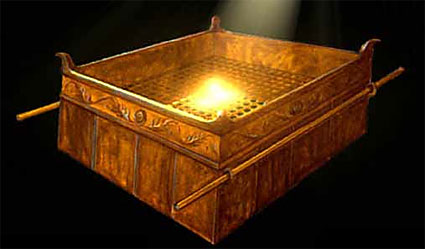Ashes and Smoke
Okay, so The Earth is Flat after all. The Atlar’s being a symbol of the mediatorial Land, (a priesthood between the heavenly sky and Gentile sea) is the key to a fair amount of weird stuff in the Bible. It also means that a lot of what goes on in the Torah is the key to understanding some later enigmatic events.
The Bronze Altar had a grate inside it to support the sacrifice. The ashes would fall through the holes in the grate and the smoke would rise as a pleasing aroma to God.
In Numbers 16, concerning the rebellion of Korah and his sons, after the “censer” showdown between them and Aaron, the ground opened up and swallowed their tents, all their belongings and their families. However, fire consumed the wannabe priests who were offering the “false” incense. Even the rebellion was divided according to the priestly divisions within Israel. Ashes and smoke. [1]
The rebels’ bronze censers were hammered out to make a covering for the altar, a memorial to their rebellion. Even their priestly possessions were “consumed” by this “Land.” The demise of these false priests was glorifying to God.
We see the same thing in Zechariah 14, except that because the Tabernacle “tower to heaven” is laid out on the ground, it is west-east instead of up-down. The Altar-mountain is split in two, the saints ascend into the Holy Place (to the East) and the rebels are swallowed as ashes.
Why is the Altar/Land/Mountain split in two? To make way for a new one. Jesus dies, the veil (the firmament) is torn and the rocks (the Altar-Land) are split. Jesus’ spirit is given up to God and then He takes our sins into the earth. Tombs open and saints are resurrected as a witness. Of course, this entire event is kind of “liturgical”—a microcosmic precursor—of events that would occur on a greater scale one generation later.
The saints under the Altar cried for vengeance upon a corrupted priesthood that had shed their blood since the death of Abel. Releasing them would require the breaking up of the old Altar-Land. They were told to wait until living saints were sealed—and slain—before they could ascend. Just as the death of Jesus as head split the rocks, the death of martyrs in Jerusalem would split the entire city. [2]
In AD70, the Herodian sons of Korah were swallowed by the Land, falling through the grate as ashes. The Old Testament saints and the New Covenant rulers—the Apostles—ascended as smoke, a pleasing aroma. This was the first resurrection. [3]
And, just as the judgments upon Jerusalem in Revelation 6-19 were a sign to the infant churches of Asia (who already contained the seeds of the same sins), the glory of the false priesthood became a memorial to any of us who would challenge the true High Priest.
The same thing happens in Revelation 20 at the second resurrection—the one we are looking forward to. Fire falls from heaven and makes a division. The World-Altar is split as a final judgment to make way for the physical New Earth.
Are you ashes or smoke? Either way it is death, a memorial to obedience or disobedience. Either way, sin is covered and God is glorified.
_____________________________________________________________
[1] An adulterous would be stoned (split rocks), but an adulterous daughter of a priest would be stoned and then burnt. Notice the harlot in Revelation would be burnt with fire. She was not Rome but Herod’s Jerusalem Inc.
[2] See also Splitting Rocks , The Peskiest Chapter in the Bible, The Falling Away, God Indivisible
[3] See The First Resurrection


























